Pothos and Philodendrons are two types of plants that are commonly used as houseplants because they’re so easy to care for. People will often mistake one for the other, but there are key differences between them, like leaves and growth habits.
In this comprehensive guide, we delve into the fascinating world of Pothos and Philodendrons, exploring their botanical identities, distinctive features, and care requirements.
What is the difference between Pothos and Philodendron? Is pothos the same as philodendron
Whether you are a seasoned gardener or someone venturing into the realm of indoor plants for the first time, this article aims to equip you with the knowledge to identify, care for, and appreciate the unique charm of both Pothos and Philodendron plants.
Here are the in-depth, related guides on both plants:
Pothos vs Philodendron Differences
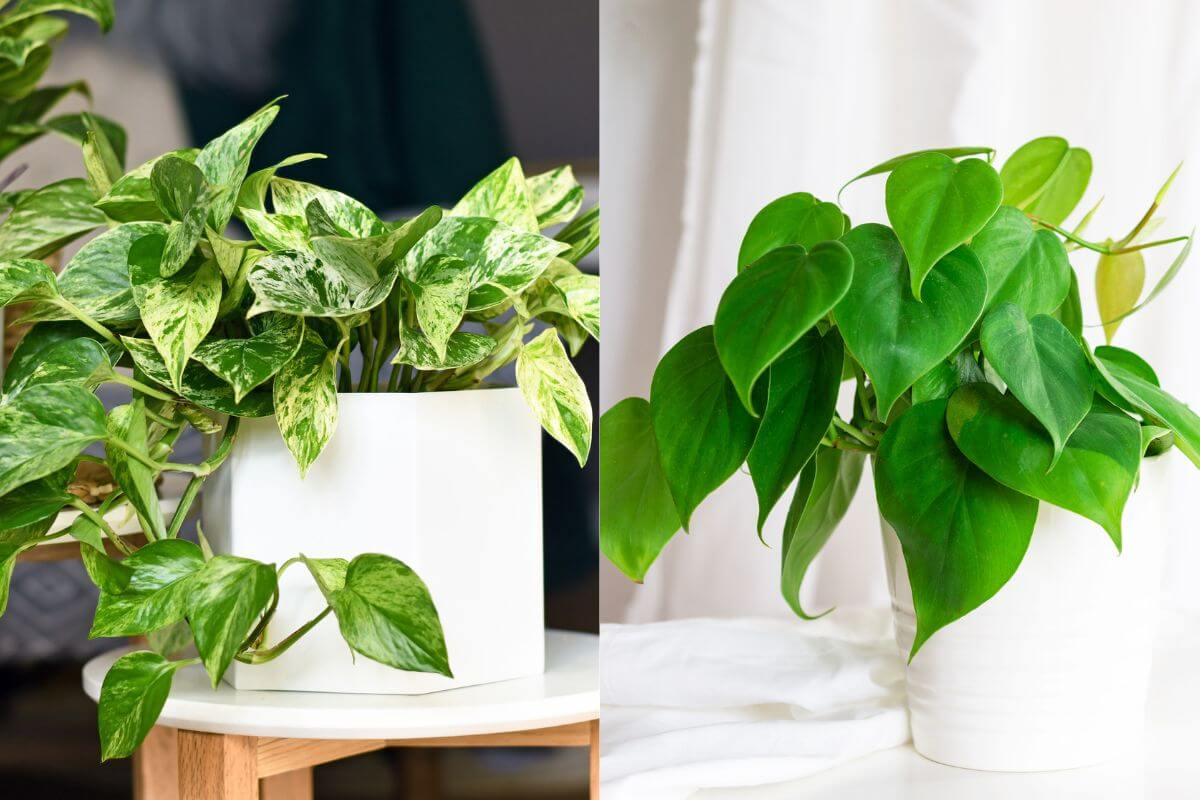
Plant Names and Taxonomy
Before diving into the specific differences between Pothos and Philodendrons, it’s beneficial to understand some basic botanical terminology that will be referenced throughout this guide. In botanical classification, plants are organized hierarchically by domain, kingdom, phylum, class, order, family, genus, and species.
This classification helps in accurately identifying and categorizing plant species based on shared characteristics.
| Family | Both Pothos and Philodendrons belong to the Araceae family, a large family of flowering plants known for their unique inflorescence and a large variety of forms. |
| Genus | The genus is a way to group species that are structurally similar or common to each other. In this case, Pothos belongs to the genus Epipremnum, while Philodendrons belong to the genus Philodendron. |
| Species | Within the genus, species are the types of plants that have more minor differences between them. For example, popular species of Philodendrons include Philodendron Bipinnatifidum, Philodendron Hederaceum, Philodendron Scandens, and Philodendron Erubescens. |
The nomenclature or naming of plants can often lead to confusion, especially when common names are used. Here’s a brief rundown on the names associated with our plants of interest:
- Pothos: Known by many names including Devil’s Ivy, Devil’s Vine, Golden Pothos, Taro Vine, Silver Vine, and Money Plant. These names often reflect either the appearance or the believed benefits of the plant.
- Philodendron: Unlike Pothos, Philodendron doesn’t have many nicknames. However, it boasts a rich variety of species each with unique botanical and common names. Some of the popular species are listed above.
Exploring Varieties: Pothos and Philodendrons
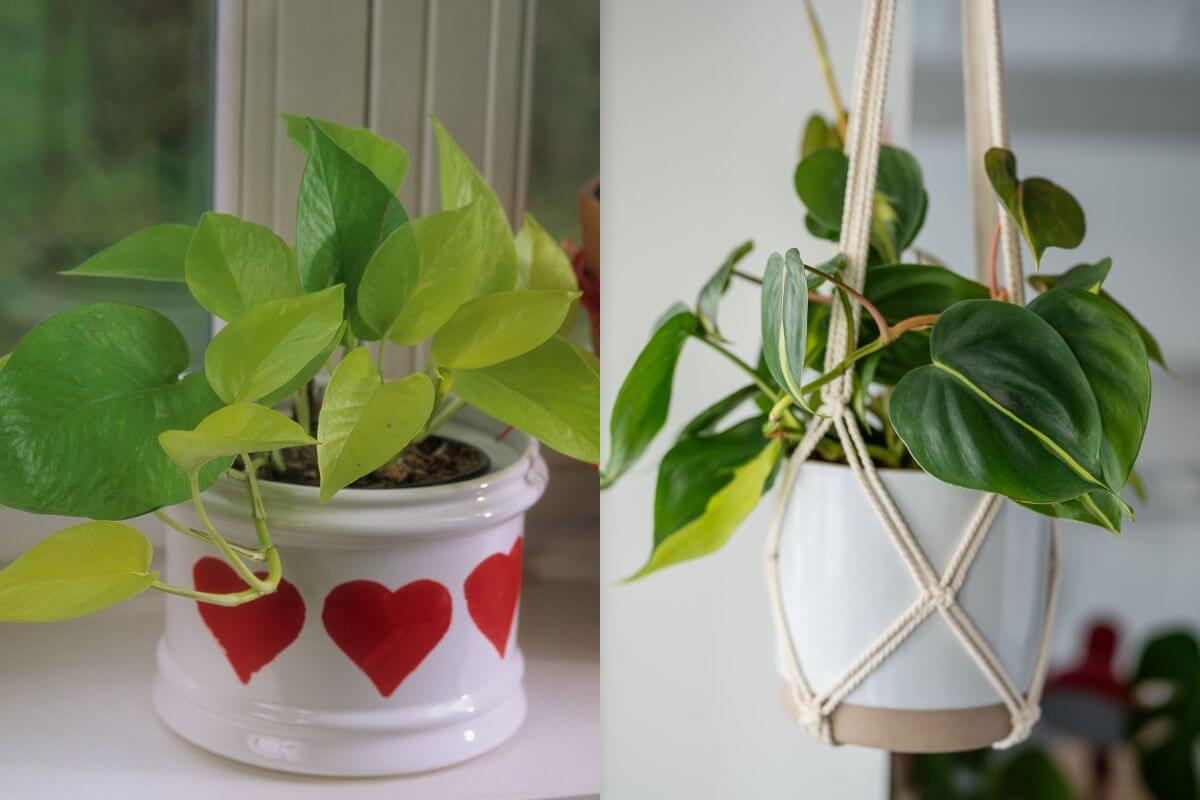
The diverse world of Pothos and Philodendrons offers a splendid array of varieties, each with unique characteristics and care requirements. Here’s a brief introduction to some of the popular varieties you might come across:
Pothos Varieties:
- Golden Pothos (Epipremnum aureum): Recognized by its heart-shaped green leaves streaked with gold or white, this variety is a classic choice among gardeners.
- Marble Queen Pothos (Epipremnum aureum ‘Marble Queen’): This variety features a creamy white marbling effect on its green leaves, adding a touch of elegance.
- Jade Pothos (Epipremnum aureum ‘Jade’): Known for its solid green leaves, the Jade Pothos is a modest yet attractive choice.
- Silver Pothos (Scindapsus pictus): Despite its common name, Silver Pothos belongs to a different genus but is often grouped with Pothos due to similar care needs. Its silver-speckled foliage is truly eye-catching.
Philodendron Varieties:
- Heartleaf Philodendron (Philodendron hederaceum): With its heart-shaped leaves and trailing vines, this variety is a favorite for hanging baskets.
- Philodendron Brasil (Philodendron hederaceum ‘Brasil’): This variety showcases stunning variegated leaves with a mix of green and yellow or cream colors.
- Red-Leaf Philodendron (Philodendron erubescens): Known for its reddish-pink foliage, this variety adds a splash of color to any indoor garden.
- Lacy Tree Philodendron (Philodendron bipinnatifidum): Unlike trailing Philodendrons, this variety grows upright and boasts large, lobed leaves.
These are just a glimpse of the myriad varieties available, and exploring them further will reveal the vast beauty and options available within the Pothos and Philodendron families. As you dive deeper, you’ll also discover the varying care needs and growth habits of different varieties, enabling you to choose the perfect plant for your space and lifestyle.
Learn more about the Varieties of Pothos and Varieties of Philodendrons.
Leaf Shapes and Textures
Both the pothos and philodendron have great looking leaves and vines, along with differences in their own varieties. But there are some general differences between the plants that will help you tell them apart easily.
While both of them have heart-shaped leaves, philodendrons are more rounded in shape than pothos plants, which tend to be more oval or oblong. Often, people will call the philodendron the heartleaf philodendron because they’re rounder, like a heart.
The leaf texture of both plants are also different. The pothos leaves are waxier and thicker, while the philodendron are softer and thinner.
Petioles / Stems
Petioles are stems that connect the leaves together on either side of the stem. They can vary greatly depending on the size of the plant.
Some petioles are very short, only reaching up to an inch long, while others may reach over six feet tall. Petiole length varies based on how big the plant gets.
In addition to this, the pothos’ petioles are usually greenish yellow, while the philodendron petioles are white.
The pothos petiole will look similar to a celery stalk in that it curves inward. The philodendron petiole is similar to most plants with it being rounded.
Aerial Roots
Both the pothos and philodendron plants have vine varieties that are climbers, and their aerial roots help them climb and vine.
Philodendron plants tend to grow aerial roots which can help them spread out over time. They can have multiple small aerial roots that spring off one node.
These root systems allow philodendron to survive when they’re cut back by gardeners. They also make it easier for philodendron to get nutrients up into their foliage.
Pothos plants will have one large aerial root growing off one node. This helps the plant stay upright as well as provide support for its weight. It also allows the plant to absorb water better through its larger surface area.
New Growth and Growth Habits
In order to provide a clearer perspective on how Pothos and Philodendrons grow over time, we’ve prepared a comparative table below. This table lays out the key differences and similarities between the growth habits of these popular houseplants.
Understanding their growth patterns can significantly contribute to successful cultivation, allowing you to anticipate their needs and enjoy their evolving beauty in your space.
The table covers the initial growth phase, leaf emergence and color transition, growth pattern, seasonal growth variation, and the long-term growth expectancy of both plants.
By navigating through this table, you’ll gain an insight into how these plants change and flourish over time, thereby making an informed decision on which plant might suit your preferences and the given environment.
| Growth Aspect | Pothos | Philodendron |
|---|---|---|
| Initial Growth | Slow initially, accelerates as the plant matures. | Starts smaller, grows quickly once established. |
| Leaf Emergence | Leaves start curled, uncurl over time. | New leaves protected by cataphylls, which fall off later. |
| Leaf Color Transition | Leaves may darken as they mature. | Leaves start yellow or pink, turn green as they mature. |
| Growth Pattern | Bushier with new shoots around the base. | Can exhibit climbing or trailing growth with support. |
| Seasonal Growth Variation | Vigorous growth in warmer season, slows in colder months. | Similar seasonal growth variations as Pothos. |
| Long-term Growth Expectancy | Can become lush and bushy, creating a full appearance. | Can grow vertically with support, adding a green ambiance. |
Whether you prefer the bushy, verdant demeanor of Pothos or the climbing, elegant stature of Philodendrons, understanding their growth habits empowers you to provide the right care, ensuring a vibrant and healthy life for your indoor foliage.
Pothos vs Philodendron Propagation Methods
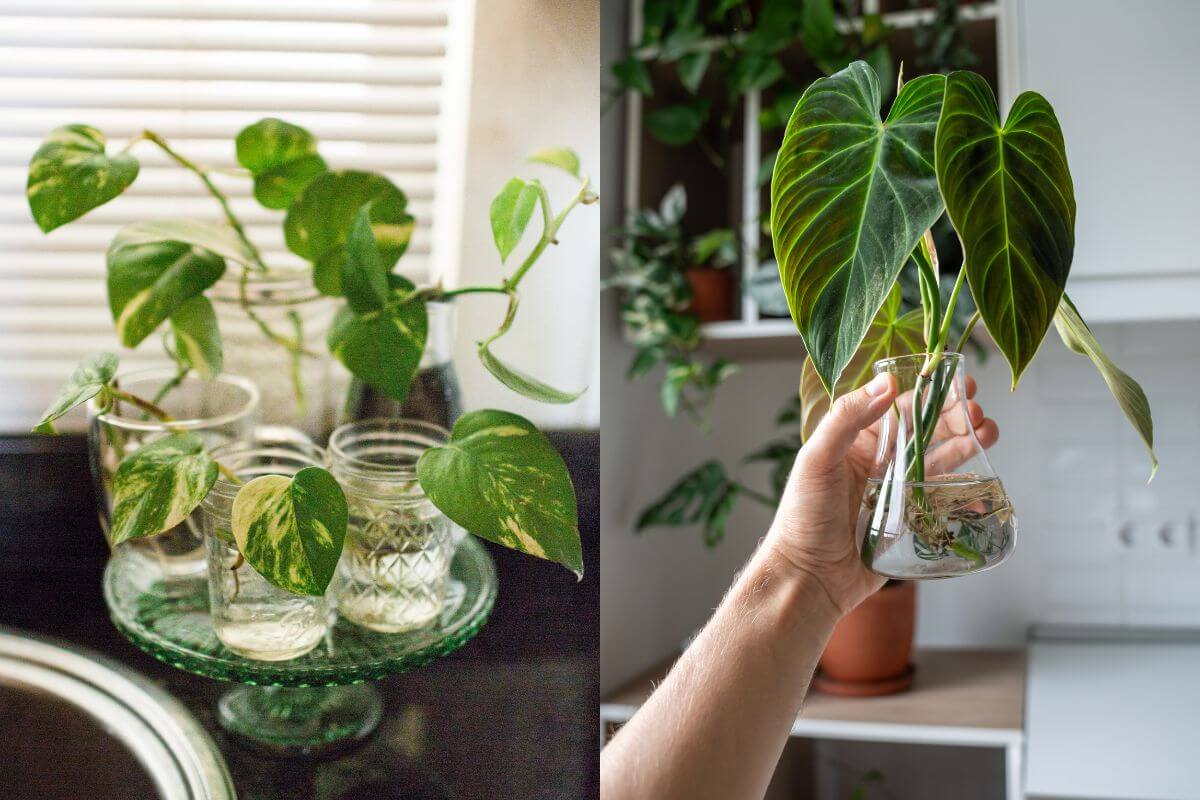
Both Pothos and Philodendrons are among the easiest houseplants to propagate, which makes them an ideal choice. Here’s a breakdown of the common propagation methods for each of these plants:
Pothos Propagation
1. Water Propagation:
- Cutting: Take a 4-6 inch cutting just below a leaf node (where a leaf attaches to the stem). Ensure there are at least 3-4 leaves on the cutting.
- Rooting: Place the cutting in a glass of water, ensuring the node is submerged. Change the water every few days to keep it fresh.
- Transplanting: Once the roots are 2-3 inches long, transplant the cutting into soil or continue growing it in water.
2. Soil Propagation:
- Cutting: Similar to water propagation, take a cutting just below a leaf node.
- Rooting: Plant the cutting in a well-draining soil mix. Keep the soil lightly moist and provide bright, indirect light.
- Transplanting: No transplanting necessary unless the plant outgrows its container.
Philodendron Propagation
1. Water Propagation:
- Cutting: Just like Pothos, take a 4-6 inch cutting below a leaf node ensuring there are 3-4 leaves on the cutting.
- Rooting: Submerge the node in water, changing the water every few days to keep it fresh.
- Transplanting: Transplant into soil or continue growing in water once roots are well-established.
2. Soil Propagation:
- Cutting: Take a cutting below a leaf node.
- Rooting: Plant the cutting in a well-draining soil mix, keeping the soil lightly moist and provide bright, indirect light.
- Transplanting: No need to transplant unless the plant outgrows its container.
3. Air Layering (for larger Philodendron varieties):
- Preparation: Choose a healthy stem and make a small upward cut about one-third through the stem, 1-2 inches below a node. Insert a toothpick to keep the cut open.
- Rooting: Wrap the cut area with moist sphagnum moss, then wrap it with plastic wrap to hold the moss in place and keep it moist.
- Transplanting: Once roots have developed in the moss, cut the stem below the rooted area and plant it in a new container.
These propagation methods offer an inexpensive and rewarding way to multiply your Pothos and Philodendron plants. The simplicity of the propagation process, along with the joy of watching new roots and leaves develop, makes it an enjoyable venture for both novice and seasoned gardeners alike.
Pothos and Philodendron Temperature Preferences
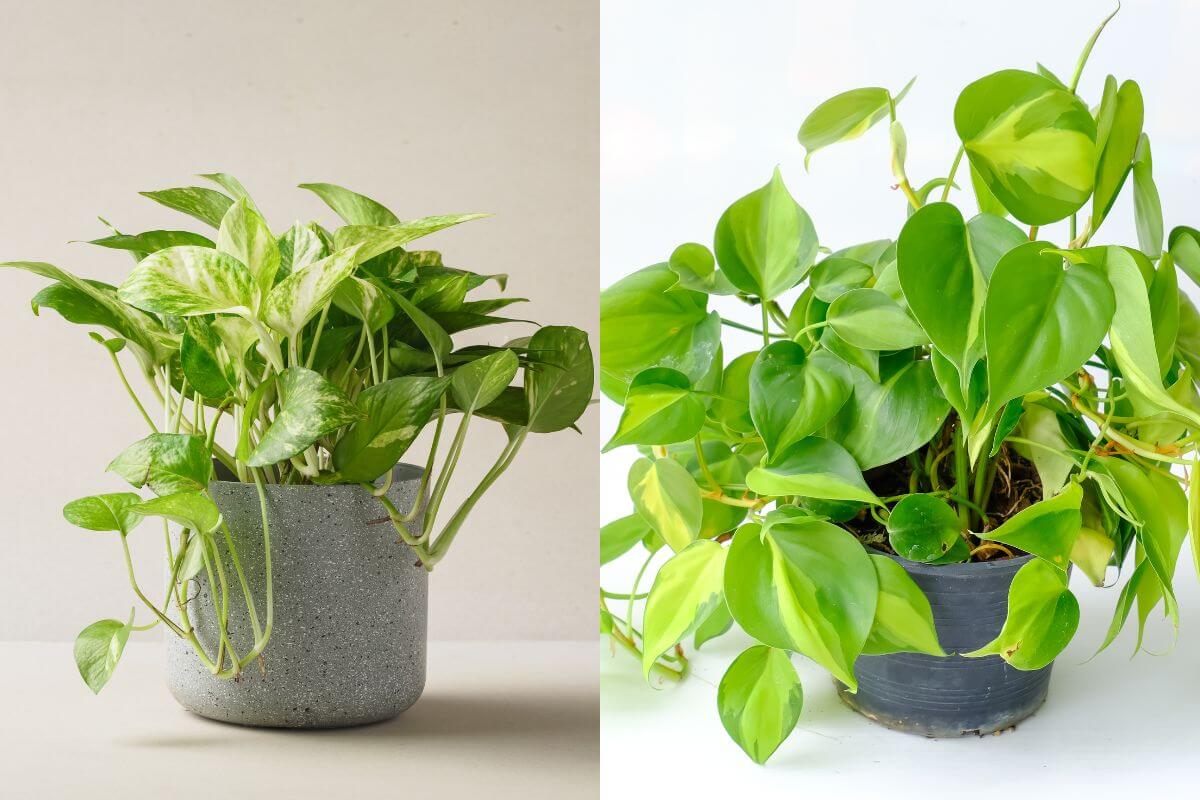
Pothos and Philodendrons thrive in tropical climates, and understanding their temperature preferences is crucial for their care. Below is a table summarizing the temperature needs and tolerances of both plants:
| Temperature Aspect | Pothos | Philodendrons |
|---|---|---|
| Ideal Temperature Range | 60°F to 85°F (15°C to 29°C) | 60°F to 85°F (15°C to 29°C) |
| Low Temperature Tolerance | As low as 50°F (10°C), growth may slow down | Below 55°F (13°C) can cause leaf drop |
| High Temperature Tolerance | Well-tolerated, avoid above 90°F (32°C) | Increase humidity & water in hotter periods |
Tips for Managing Temperature
- Indoor Placement: Ensure a stable temperature by placing plants away from drafts, heating vents, or air conditioners.
- Outdoor Placement: Provide a shaded spot outside during summer or in warmer climates to protect from extreme temperatures.
- Monitoring: Utilize an indoor thermometer to monitor temperature, especially important during winter when indoor heating can cause fluctuations.
By adhering to the temperature preferences of your Pothos and Philodendron plants, you’re promoting a healthy growing environment, mirroring their native tropical habitats.
Watering and Soil Requirements
Understanding the watering and soil preferences of both Pothos and Philodendrons is essential for their healthy growth. While they share some similarities, there are also distinct differences.
Here is a table summarizing their watering and soil requirements:
| Aspect | Pothos | Philodendrons |
|---|---|---|
| Watering Frequency | Allow soil to dry between waterings | Prefer consistently moist soil |
| Watering Tip | Better to under-water than over-water | More frequent watering during growing season |
| Soil Type | Well-draining, peat moss-based mixture | Well-aerated, peat-based potting mix |
| Soil Mixture | Potting soil, perlite, and orchid bark | Potting soil mixed with perlite and orchid bark |
Tips for Optimal Watering and Soil Management
- Check Soil Moisture: Before watering, check the soil’s moisture levels by sticking your finger into the soil up to 2 inches deep. If it feels dry, it’s time to water.
- Drainage: Ensure your pots have drainage holes to prevent waterlogging, which can lead to root rot.
- Water Quality: Both plants prefer rainwater or distilled water as tap water may contain chemicals that can be harmful over time.
- Soil Aeration: Every few months, gently loosen the soil using a fork to aerate the soil, ensuring better water absorption and root health.
The table above allows for a quick comparison, making it easy for you to understand and manage the watering and soil needs of your Pothos and Philodendrons, ensuring they thrive in their environment.
Fertilization Needs
Fertilization is key to maintaining the healthy growth and lush foliage of both Pothos and Philodendrons. Though they share the same family, their fertilization requirements vary slightly. Below is a table summarizing their fertilization needs:
| Aspect | Pothos | Philodendrons |
|---|---|---|
| Fertilizer Type | Balanced liquid fertilizer (20-20-20 formula, diluted to half-strength) | Balanced liquid fertilizer or a foliage fertilizer with a higher nitrogen content (20-10-10 formula) |
| Fertilization Frequency | Every 4-6 weeks during the growing season (spring and summer) | Every 2-4 weeks during the growing season |
| Special Consideration | Not heavy feeders; avoid over-fertilization to prevent salt buildup in the soil | Appreciate consistent fertilization, especially the vining varieties |
Tips for Successful Fertilization:
- Dilution is Crucial: Always dilute the fertilizer according to the instructions on the package to avoid fertilizer burn.
- Consistency: Stick to a consistent fertilization schedule to meet the nutritional needs of your plants.
- Check Soil Health: Over time, fertilization can lead to salt buildup in the soil, which can be harmful. If you notice white crust forming on the soil surface, it may be time to repot your plant or flush the soil with plenty of water to remove excess salts.
- Foliar Feeding: Occasionally, you can apply liquid fertilizer directly to the foliage of Philodendrons for quicker nutrient absorption.
These fertilization guidelines outlined in the table, will help you be better equipped to provide the necessary nutrients for your Pothos and Philodendrons, ensuring their vibrant growth and overall health.
Pest and Disease Management
Both Pothos and Philodendrons are relatively resistant to pests and diseases. However, like any other plants, they can be affected by certain issues if not properly cared for. Below is a table summarizing common pests, diseases, and their respective management practices for both plants:
| Issue Type | Common Issues | Pothos Management Strategies | Philodendron Management Strategies |
|---|---|---|---|
| Pests | Spider mites, Mealybugs, Aphids, Scale insects | • Use insecticidal soap or neem oil. • Remove affected leaves. • Ensure proper ventilation and humidity. | Same as Pothos. |
| Diseases | Root rot, Leaf spot, Fungal infections | • Avoid over-watering. • Use well-draining soil. • Ensure good air circulation. • Remove and discard affected leaves. | Same as Pothos. |
| Preventative Measures | • Regular inspection for pests. • Avoid waterlogging the soil. • Quarantine new plants before introducing them to your space. | Same as Pothos. |
Tips for Effective Pest and Disease Management:
- Early Detection: Regularly inspect your plants for signs of pests or diseases. Early detection and intervention can prevent minor issues from escalating.
- Natural Predators: Introduce natural predators like ladybugs to control pest populations.
- Proper Ventilation: Ensure your indoor garden has proper ventilation to deter fungal infections.
- Hygiene: Keep the area around your plants clean to deter pests and diseases.
By following these management strategies and preventative measures, you can maintain a healthy growing environment for your Pothos and Philodendrons, free from plant diseases and pests.
Pothos and Philodendron Similarities
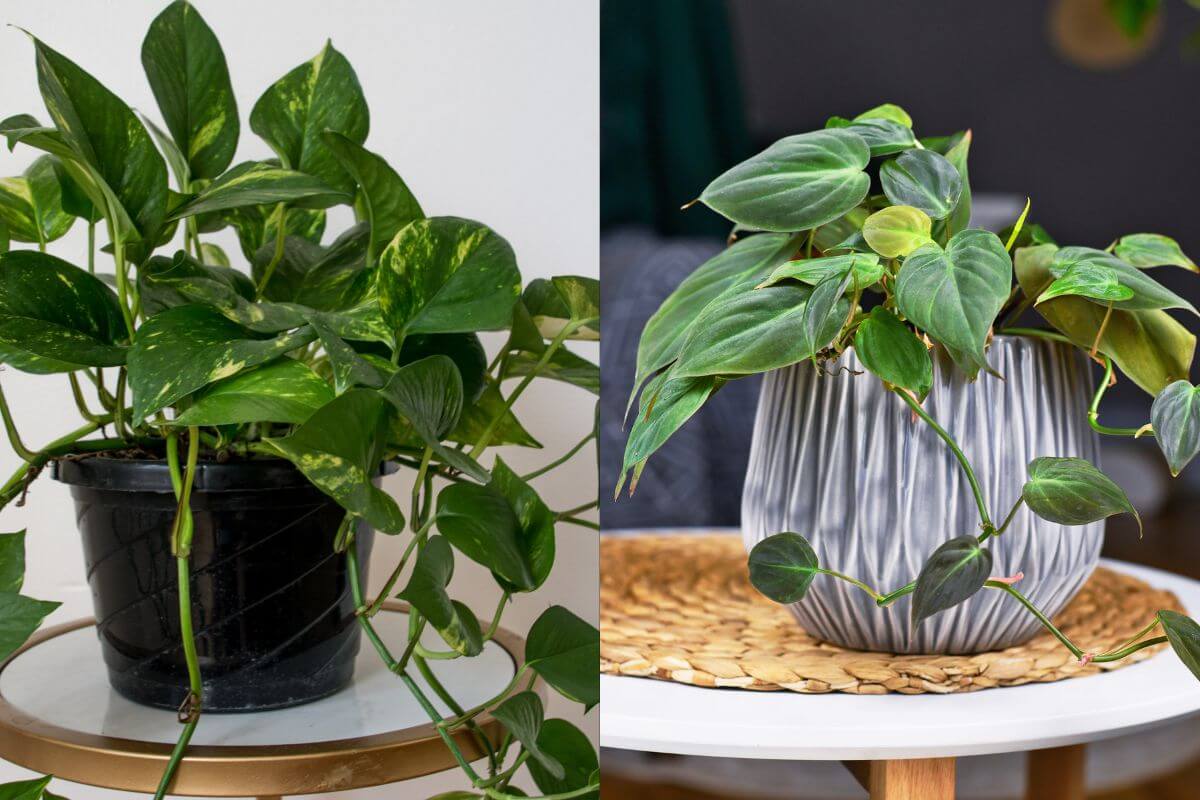
Even though they have differences, there are also some philodendron vs pothos care similarities between these two plants when it comes to the environmental conditions for growth.
Both the pothos and philodendron plants can be grown indoors or outdoors.
They can both grow in low light conditions, but do best in bright indirect light. If you want your pothos or philodendron to thrive outside, try planting it in partial shade with dappled sunlight.
If you live somewhere where temperatures drop below freezing during winter months, keep your pothos or philodendron indoors.
When it comes to soil conditions, both of them like moist soil, but not soggy or the roots will rot. They like well-draining soil. The pothos is more drought-tolerant when it comes to watering and keeping the soil moist.
Pothos vs Philodendron Plants Final Thoughts
In the end, the pothos and philodendron plants are different from each other. However, if you know what characteristics you’d like your houseplant to possess, you should be able to find something suitable for your home.
Read more about houseplants in these related articles:
- Best Indoor Plants to Grow
- Most Colorful Houseplants to Grow
- Snow Queen vs Marble Queen Pothos
- Peace Lily Flowers Turning Brown, Green, and Black
- Black Cardinal Philodendron Care Guide
Pothos vs Philodendron FAQs
Can you plant pothos and philodendron together?
Yes, you can plant the pothos and philodendron together as companion houseplants! They have similar requirements when it comes to light, soil, and water needs.
Which is easier pothos or philodendron?
Pothos plants are easier to grow than philodendrons. They are both easy to care for and have similar needs with water, light, and soil. Pothos plants are a bit more tolerant when it comes to light and water though, so it is easier to care for. The pothos will be more forgiving if it’s neglected a little.
Is a golden pothos a type of philodendron?
No, the golden pothos is not a type of philodendron. It’s actually a type of pothos plant that has been bred specifically for its yellow coloration with its heart-shaped green leaves. This particular variety was created by crossing several species of pothos into one single hybrid.
Is silver pothos a philodendron?
No, the silver pothos is actually a pothos cultivar that has been selected because of its silver spots on its green leaves. It looks very similar to the common pothos, except for the fact that it doesn’t produce any flowers at all. Instead, this plant produces small white berries on its stems. These berry clusters look really pretty against the foliage of the plant.
Are the pothos and philodendron plants poisonous?
Yes, the pothos and philodendron plants are both toxic. Both contain insoluble calcium oxalate crystals, which can cause irritation to the skin, mouth, and eyes. Keep them away from your pets and small children. If your cats or dogs happen to chew or eat either of their leaves and start exhibiting symptoms, be sure to call a vet or poison control immediately.

